Home »
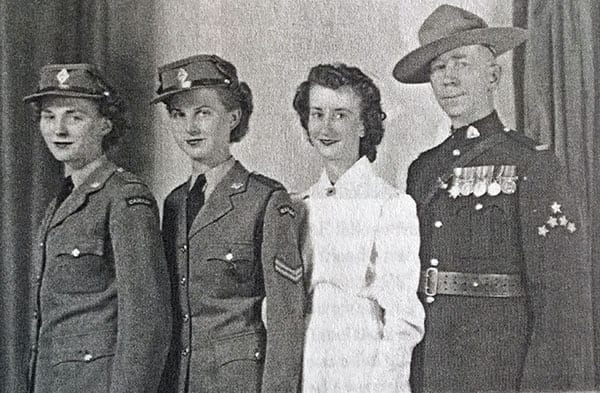
Veteran Jean Hubbard joined army on 18th birthday
By Elinor Florence
Jean Hubbard, now aged 92, joined the Canadian Women’s Army Corps on her 18th birthday. Wearing her red and white polka-dotted dress, she is likely the only recruit ever welcomed into the armed forces with a birthday cake! I visited Jean recently at her lovely West Vancouver home, where she told me all about it.
Jean was born on May 10, 1926 in Canora, Saskatchewan, to David and Ruth Brims. Her father was a member of the South Saskatchewan Provincial Police, and then transferred into the Manitoba Provincial Police, and finally the Royal Canadian Mounted Police in Manitoba.
The couple had three girls: Mary, Gladys, and finally Jean. When Jean was just three years old, her parents separated. Her father insisted on keeping the three little girls with him, and her mother departed.
Later her father remarried a kind and loving woman named Irene. The family moved around Manitoba, and Jean finished her Grade 11 in Hamiota before her father was promoted to Flin Flon.
By then both her older sisters had left home. Mary was training to become a nurse in Brandon, and Gladys had joined the Canadian Women’s Army Corps. Jean decided to follow in the footsteps of her big sister Gladys, and enlist as soon as she turned 18-years-old.
Her father took her to the train station, where she boarded the train to Winnipeg. “My father was wearing his red serge, and as the train pulled out of station he stood at attention and saluted me,” Jean recalls. “I’ll never forget that moment.”
In Winnipeg, Jean stayed overnight at the Fort Osborne army barracks. The next day – May 10, 1944 – was her 18th birthday. After her medical exam, and swearing the Oath of Allegiance, she was ushered into another room where her sister Gladys was waiting for her, along with a couple of officers, a cameraman, and a birthday cake! The cake had one candle on it, indicating her first day in the army!
“Gladys had told them it was my birthday, so they thought this was a good opportunity for a publicity shot for recruiting women, and they had it all arranged ahead of time.” That photograph later appeared in the Winnipeg Free Press, and Jean enjoyed her few brief moments of fame.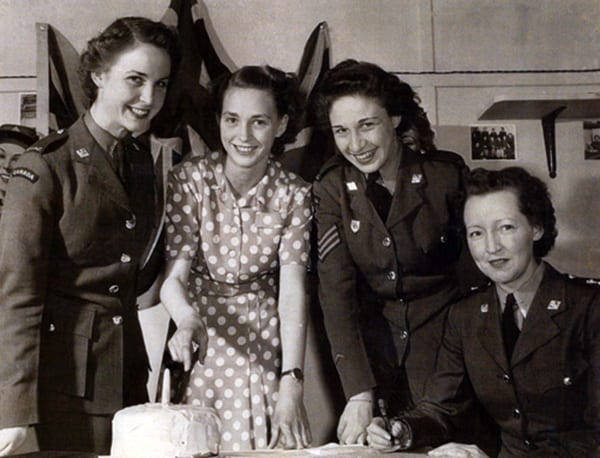
After the cake photo, Jean was fitted out in uniform, loaded onto a truck with a group of other young women who had joined the Canadian Women’s Army Corps (called CWACs for short), and taken to the train station. She was on her way to Kitchener, Ontario, for basic training.
It was on the train that the male and female recruits mingled together, talking and laughing as the train chugged across the northern shield. A tall, handsome blond boy named Tom Hubbard from Maidstone, Saskatchewan, started talking to Jean.
The male army recruits on the train were headed for Camp Borden, Ontario, while the women went on to Kitchener. Before parting on the third day, Tom and Jean, both of them in tears, exchanged addresses.
“While I was in Kitchener, Tom and I saw each other only twice when he visited me on weekend leaves. When he received his overseas posting, we spent the last weekend dancing together and then he left with the South Alberta Regiment.” This was an armoured division equipped with tanks.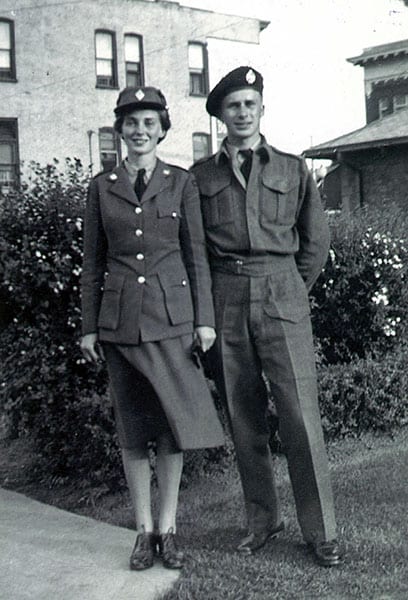
Meanwhile, Jean began her basic training, drilling and marching, and learning how to follow the rules and live with hundreds of other young women. More than two-thirds of the CWACs took their training at Kitchener.
By war’s end, more than 21,000 women had served in the army. Initially, their duties were quite traditional and they worked as cooks, cleaners, tailors and medical assistants. However, these duties would expand to include more traditionally male jobs such as driving trucks and ambulances, and working as mechanics and radar operators.
While most women served in Canada, about 3,000 of them were posted overseas. There was no question of Jean going overseas, since you had to be twenty-one years old to qualify. So she volunteered for secretarial training, wisely concluding that this would be a useful skill in later life.
The twenty girls in her secretarial class marched one hour in the morning from Kitchener to Waterloo, spent the day studying, and marched back again. Jean earned her Lance-Corporal stripe in for getting everyone up in the morning and ready to depart! As in the men’s army, stripes on your sleeve indicated rank – one stripe for Lance Corporal, two stripes for Corporal, three stripes for Sergeant and so forth.
This photos shows the three sisters, home on leave: Gladys on the left has already received her two stripes, Mary is in her nurse’s uniform, and Jean has yet to receive her first stripe.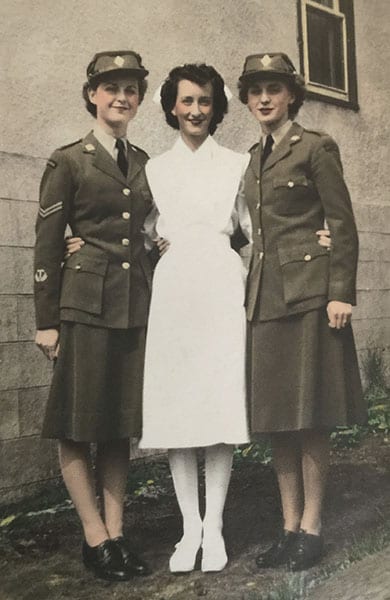
Staff-Sergeant Brims was so proud of his three daughters that he arranged to have a portrait taken (lead image above).
Several months later, Jean completed her training and was posted to the Central Mechanization Depot in London, Ontario, and that’s where she spent the duration of the war, working in administration. Known as Canada’s largest Army garage, this is where all the army’s trucks, tanks, and other vehicles were taken for servicing and repairs.
While in London, Jean earned her second stripe when she was promoted to Corporal, and earned a small but welcome pay raise. By then her sister Gladys had her third stripe, making her a Sergeant. “My father said jokingly that she had better slow down or she would reach an equal rank with him! My father was a Staff-Sergeant in the RCMP.”
This photo shows RCMP Staff-Sergeant Brims shaking hands with his eldest daughter, Sergeant Gladys Brims.
It wasn’t typical for women back then to fly in airplanes, especially not women in the army rather than the air force, but Jean did get the thrill of a lifetime.
She made a friend in the armed forces named Gord Cameron from the nearby men’s barracks, and one day he asked Jean to come to the London airport for open house day.
“We joined a conducted tour and I noticed Gord speaking privately to our guide. Then he took my arm and led me over to a small two-seater airplane sitting on the tarmac by itself. Gord told me he had gotten permission to sit in it. He boosted me up into the seat behind, and then he got into the pilot’s seat and started the engine. The next thing I knew, we were taking off!
“We flew all over London and when we went over the women’s barracks, my friends were all standing outside waving white towels because Gord had told them ahead of time about the surprise!”
Gord wanted to marry Jean, but she said no because she was still carrying a torch for her Saskatchewan soldier. “I sent him packages of cookies and candy. I made him a record of our song, “I’ll Get By.”’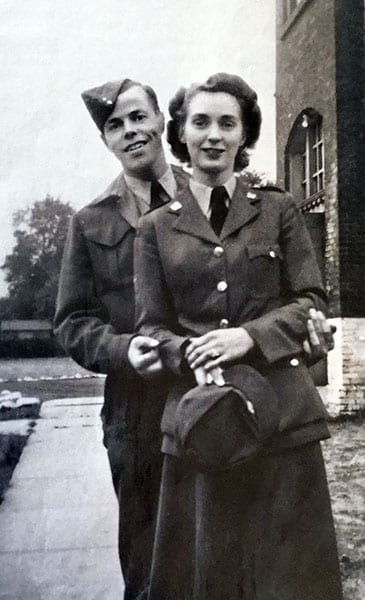
“Tom told me later that he didn’t have a phonograph needle, so he had to use a sharpened toothpick. My singing wasn’t the greatest, so I can only imagine how the record sounded!”
Jean was demobbed in February 1946. She returned to Manitoba and found work at the Hudson Bay Company in Winnipeg, after taking a refresher course in shorthand, while she waited for Tom to come home.
The South Alberta Regiment was equipped with tanks and deployed to France in 1944. Tom participated in the liberation of Holland, and spent the last weeks of the war fighting in Germany. After the war ended, he continued to serve with the occupying force in Germany for several months.
Finally, the long-awaited day arrived in June 1946 and Jean went down to the Winnipeg train station. “I was wearing my best outfit, and a little hat with a veil.” Tom immediately asked Jean if she could come home with him to Maidstone and meet his family.
Jean arranged some time off her work, and the pair took the train to Saskatoon, where they were met by Tom’s family and driven to Maidstone, about 250 kilometres away. Tom’s father was the elevator agent in Maidstone.
However, life wasn’t going to be that easy. Jean returned to her job in Winnipeg, and Tom was accepted into the Forestry program at the University of British Columbia in Vancouver. They didn’t see each other again until Christmas, when they met in Maidstone for the holidays.
“There was a Christmas cracker on the tree and Tom told me to open it. Out popped a diamond solitaire ring!” They decided not to be separated any longer, so Jean left her job in Winnipeg and accompanied Tom back to Vancouver. She lived at the YWCA downtown while Tom lived at the UBC campus in Fort Camp, an old barracks converted into living quarters for military students.
Jean found work as a secretary at the Birks Jewellery store, and they set the date for September 10, 1947.
“My friend Jean Kelly of Brandon, Manitoba was already married, but I hadn’t been able to attend her wedding. When we were planning our wedding, money was scarce, so we only invited our parents and a few friends who lived in Vancouver. I intended to wear a suit that I could use later for work.
“A few weeks before the wedding, I received a parcel from Jean in Brandon – her wedding dress, veil, and long, lacy gloves. The dress fit perfectly! I felt like a princess as I walked down the aisle of Christ Church Chapel in Vancouver holding my father’s arm. I hadn’t told Tom about the dress and his smile and the look in his eyes told me that I looked as beautiful as I felt!”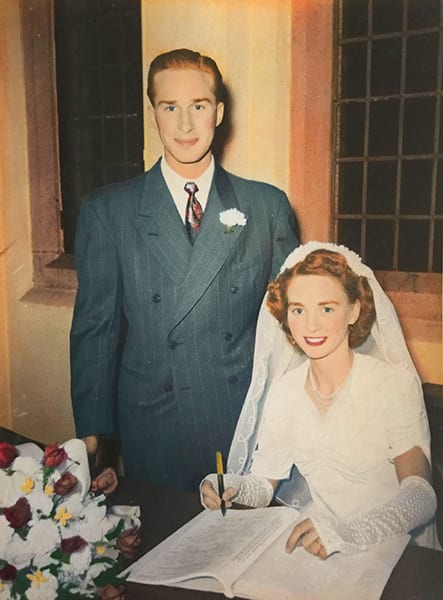
Tom finished his degree and became a registered forester. The Hubbards moved to Nelson for 13 years, then transferred back to the coast in 1969, when they purchased a mountainside home in West Vancouver with a spectacular ocean view, the home where Jean still lives alone today. Sadly, Tom spent only a year in his new home before dying of lung cancer in 1970.
With three children to support, Jean found a job at the federal government’s Customs and Excise branch in Vancouver and worked there until her retirement in 1981. She also married again, to a wonderful man named John Cooper whom she met through her work. The couple purchased a camper and travelled extensively throughout North America and Europe before he died in 2005.
Today Jean still enjoys watching the ships in the harbour, and raising flowers and vegetables on her sunny deck. Both of her daughters, Carol and Linda, live nearby on the North Shore, while her son Dave lives in Edmonton. She also has three grandchildren.
From her second marriage, she has four stepchildren, four step-grandchildren, and four step-great-grandchildren and still considers herself part of the Cooper family.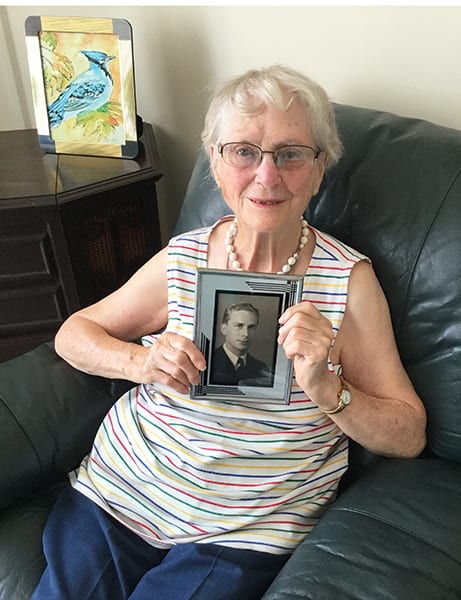
Of her days in the army, Jean says: “It was a privilege for me to follow in my father’s footsteps. He served in the Canadian Army during the First World War and he was gassed at the Battle of Vimy Ridge and took months to recover. He then went on to serve our country as a member of the RCMP. We had big shoes to fill, but I know he was proud of all three of us girls.”
This Remembrance Day, please remember those living veterans who are still among us. Thank you, Jean Brims Hubbard, for your service to our country.
Lead image: From left: Jean Brims, Gladys Brims, Mary Brims, and their father.

– Career journalist and bestselling author Elinor Florence of Invermere has written two wartime books. Her novel Bird’s Eye View tells the story of an idealistic Saskatchewan farm girl who joins the Royal Canadian Air Force and becomes an interpreter of aerial photographs. My Favourite Veterans is a non-fiction collection of interviews whose stories appeared previously on e-KNOW, including Cranbrook’s own Bud Abbott.
Elinor’s new novel Wildwood, about pioneer life in the Peace River, Alberta region, will appear in February 2018. It is available for pre-order now at a reduced price on Amazon. For more information about all three books, visit Elinor’s website at www.elinorflorence.com or call her at 250-342-1621.







